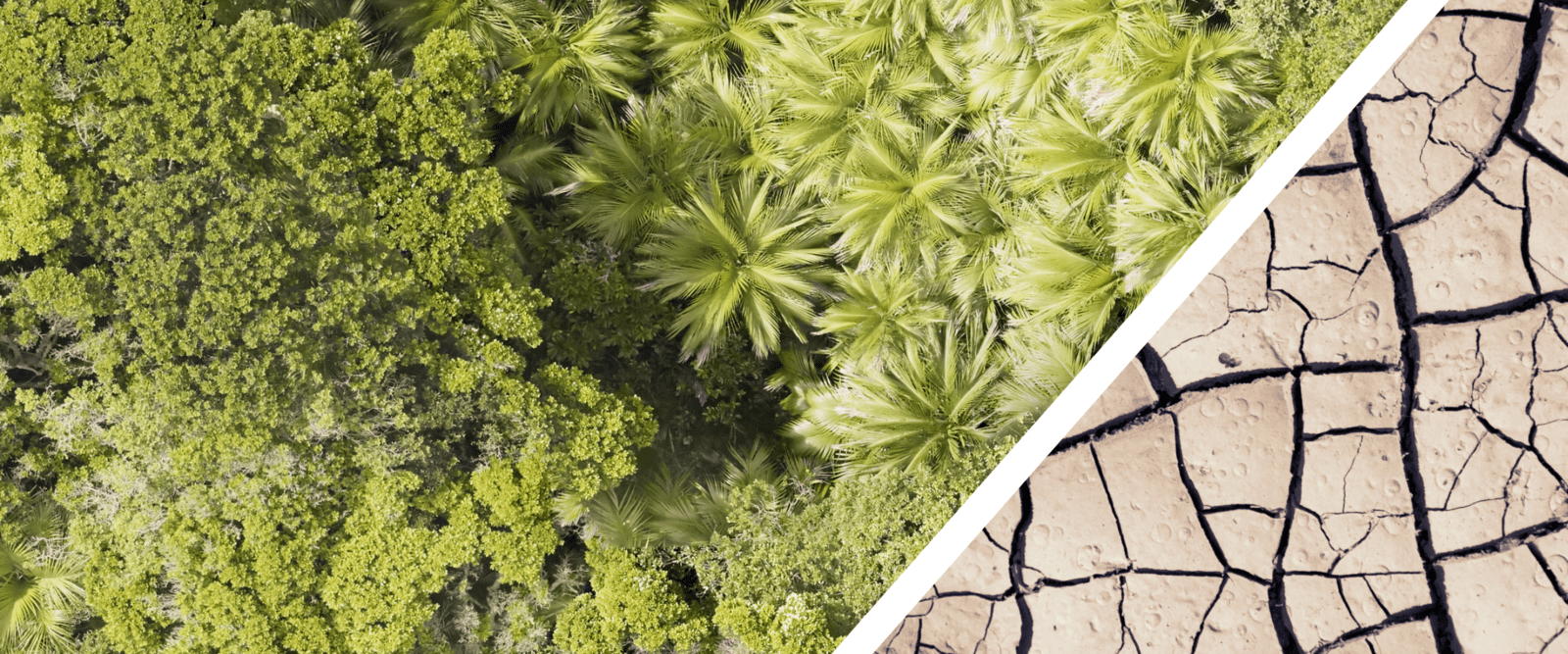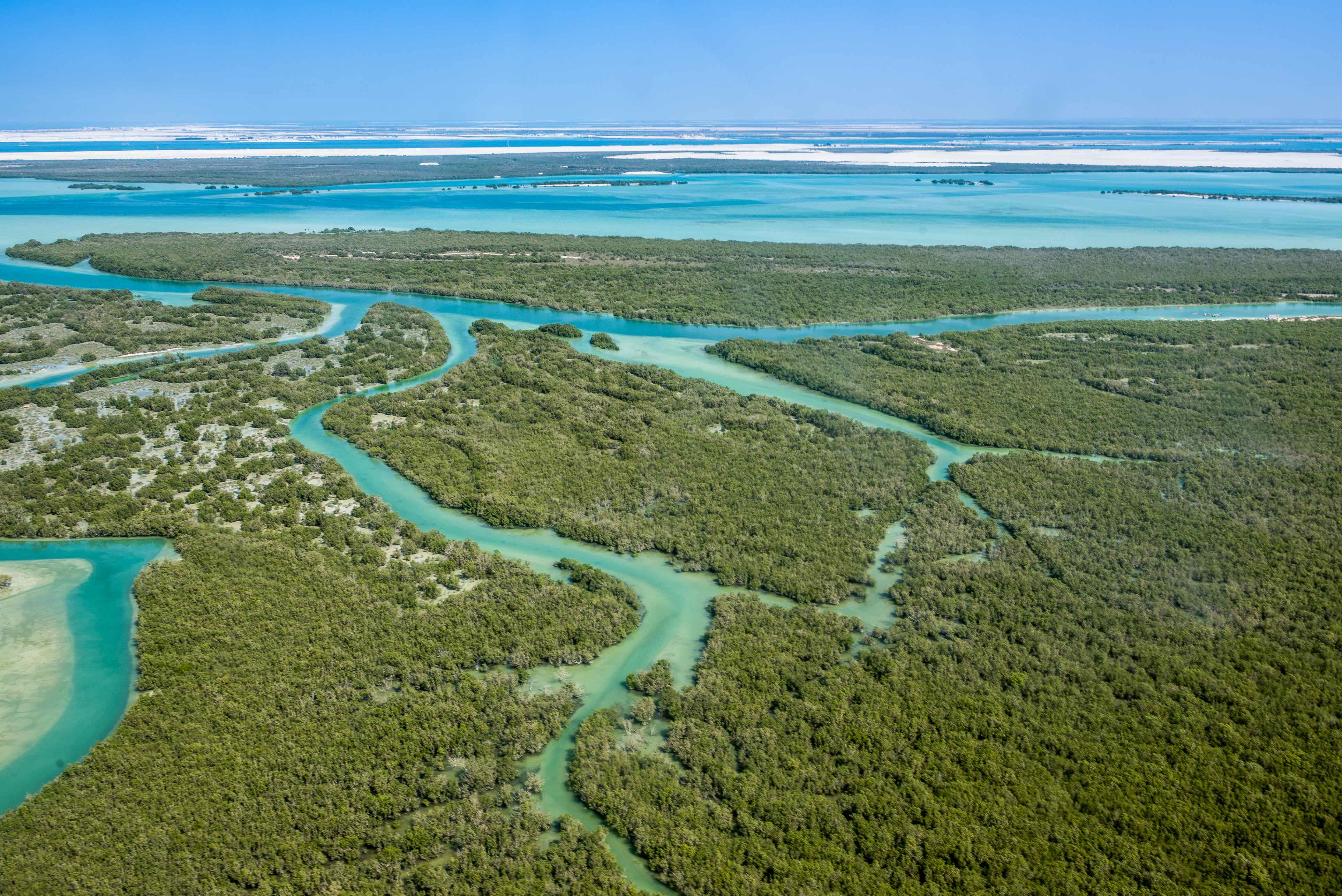In March 2019, The United Nations declared 2021-2030 the Decade on Ecosystem Restoration, with the aim to prevent, halt and reverse the degradation of ecosystems on every continent and in every ocean. Natural ecosystems are key to stop mass extinction, combat climate change and build the resilience of the communities more vulnerable to climate-related extreme events and other economic, social and environmental disasters.
The rate of biodiversity loss today is more than 10x higher than it’s been for the last 10 million years, with around 1 million species already extinct¹. Biodiversity is critical to maintaining ecosystems and increasing their productivity: each species has a specific role to play. This is a vital foundation for sustainable development and human well-being (including food security, nutrition, access to water and health). Some habitats like forests are the most biologically diverse ecosystems on land, home to more than 80% of the terrestrial species of animals, plants and insects².
Today, land degradation is still higher than land restoration and contributed around a quarter of greenhouse gas emissions in 2010–2019³. On top of that, we are also damaging the single largest nature-based opportunity for climate mitigation; forests and other natural ecosystems mitigate climate change through carbon sequestration, contributing to the balance of oxygen, carbon dioxide and humidity in the air.
Natural habitats also have a significant role in reducing the risk of natural disasters, including floods, droughts, landslides and other extreme events. Restoring natural habitats represents an investment in people and their livelihoods. Around 1.6 billion people⁴ – including 70 million indigenous people – depend on these habitats to provide shelter, jobs and security.
Ecosystem restoration can simultaneously mitigate climate change, slow and reverse biodiversity decline and increase the benefits people get from nature.
But what is the real meaning of Ecosystem or Ecological Restoration?
According to SER (Society of Ecological Restoration), we can define Ecological restoration as the “process of assisting the recovery of an ecosystem that has been degraded, damaged, or destroyed”. Ecological restoration seeks to initiate or accelerate the process to re-establish a self-organising ecosystem on a trajectory to reach full recovery and return to its historic trajectory⁵.
There are many activities associated with ecosystem restoration, from removing invasive species or reintroducing lost species to as complex as altering landforms, planting vegetation and reintroducing wildlife. We’ve identified the ten actions that are key not just to set the initial trajectory of recovery for that ecosystem but that can ensure its full recovery across the following years and decades.
1- Understanding the health of an ecosystem over time is what paints a holistic picture of the ecosystem and its restoration journey.
2- Preserving existing biodiversity builds more resilient and adaptable ecosystems, enhancing their productivity and the ecological services they provide to communities.
3- Weed management is critical, particularly during the initial growth phase of trees, since they can severely threaten newly planted species’ survival.
4-To restore healthy ecosystems, it is necessary to restore their ecological integrity, including rehabilitating the soil.
5- To select the right species to plant, local provenance and a high level of genetic diversity are key factors to consider since they increase the chance of successful establishment and the ecosystem’s ability to evolve and recover from disturbances.
6- Optimising sowing volumes within the appropriate season is crucial, and it needs to be adapted to each site and ecosystem’s unique characteristics.
7- Seeds are a limited resource, so they need to be carefully managed and prepared to ensure the seedling establishment.
8- Plant growth-promoting rhizobacteria, which can be inoculated in seeds, could successfully colonize plant roots and positively enhance plant growth and help the species survive.
9- Regular monitoring is critical to improving restoration programs’ performance, which is one of the many reasons why environmental managers and indigenous communities have a crucial role in the ongoing stewardship of the lands we restore.
10- Ecosystem restoration activities need to undertake an adaptive management approach to the changing variables of our constantly evolving environmental conditions due to climate change.
Let’s analyse more in depth each of these actions.
1- Assess Ecosystem Health
Ecosystem health is a measure of the status and potential of an ecosystem to maintain its organisational structure, sustain its capacity to function, and be resilient under stress to continuously provide quality ecosystem services for present and future generations in perpetuity. This measure is based on a combination of three interlinked elements:
– Ecosystem Condition: identifies how far the ecosystem is from a ‘good’ state. Condition indicators include land cover, forests, soil carbon, species diversity, freshwater, amongst others.
– Ecosystem Function: assesses the extent to which the ecosystem can self-organise its natural function and deliver a range of ecosystem services6. This includes indicators such as connectivity, meaning how well species can move from one habitat area to another and regulate excess levels of acid and nitrogen pollution, which produce acidification and eutrophication processes and can dramatically harm certain habitats.
– Ecosystem Permanence: evaluates to what degree the health of the ecosystem can be self-sustained under human and environmental pressures, including climate change, pollution and natural disasters. Indicators would include non-native species (weeds), climate change adaptation, soil sealing, amongst many others.
Understanding and continuously monitoring an ecosystem’s health is crucial to plan for the right restoration strategy and accelerate early interventions, being more effective and delivering better rehabilitation outcomes.

The Millenium Ecosystem Assessment defines Ecosystem services as “the benefits that people obtain from ecosystems”. This encompasses both goods, such as timber, and services such as air purification. They are divided into four categories, supporting, provisioning, regulating and cultural 7. Graphic credit: TEEB Europe
To assess an ecosystem in its entirety, understanding these three elements at the highest level, all the way down to individual species level is key. Given ecosystems are living and changing, understanding this over time is what paints a holistic picture of an ecosystem and its restoration journey.
2- Identify and Preserve existing Biodiversity
Biodiversity is the variation of living things on Earth, and an ecosystem’s health depends on its biodiversity. Preserving biodiversity builds more resilient and adaptable ecosystems, provides food and medicine and supports ecosystem functions such as decomposing organic waste and filtering and cleaning freshwater, enhancing life’s resilience on Earth.
Today’s rate of biodiversity loss is more than 10x higher than it has been for the last 10 million years, with around 1 million species already extinct⁸ and 1 million threatened of extinction⁹.
“High species and functional trait diversity enhance productivity, ecosystem resilience and the provision of forest products and ecological services to local communities. The ideal achievable outcome is the maximisation of natural biodiversity, particularly functional diversity, within current and future climatic and edaphic limitations, while acknowledging that tree species composition may differ from that of pre‐deforestation tree communities”¹⁰.
One challenge in restoration is bringing back biodiversity when it is not just one species to bring back, but several. In these cases, the threats to restoration from other invasive species, inhospitable soil conditions and microclimates, pose a continuing threat to restoration. In some cases, pioneer species can pave the way for others, creating that microclimate for all other species to thrive. However, so often, it is the case that restoration is done in waves with multiple interventions over time to successfully establish each of the key species within an ecological community.
A successful regeneration effort is this case from the Hawaiian archipelago, where 238 endemic Hawaiian plant species have fewer than 50 individuals remaining in the wild. Using different approaches, they have managed to save threatened plant species like the Cyanea grimesiana, which from only three wild individuals; restoration managers have been able to restore and conserve this species population, saving it from extinction.
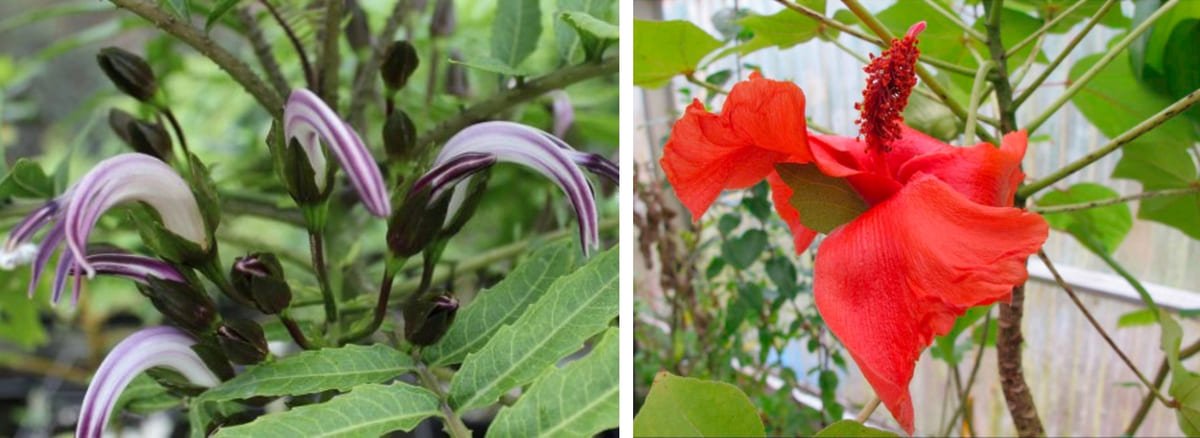
Cyanea grimesiana (endangered species) and Kokia cookei (extinct in the wild species). Photo credit: University of Hawai’i at Mānoa.
3- Focus on Weed Management
Weed management is critical when planting, particularly during the initial phase, which may last up to five years. Weeds compete for nutrients, water and light, and can severely threaten the survival and early growth of newly planted trees.
There are different types of weed management, and there are different factors to be considered when choosing a weed control strategy, from land fertility, environmental factors and timing.
It’s important to monitor the weed management programs’ progress closely, document and evaluate conditions, treatments, and results continuously.
A fantastic example of weed management is currently taking place in Lord Howe Island [LHI], a World Heritage Site located off the coast of NSW, Australia. Vegetation covers 87% of LHI, and 75% is designated as a Permanent Park Preserve. LHI is home to 113 plant species that exist nowhere else in the world. To date, 20 species on LHI have become extinct, and up to 50 species are listed as threatened. The world heritage site is working on a holistic island-wide restoration programme to protect this paradise, particularly from invasive species that threaten the island’s unique environment. For example, Ground Asparagus (Asparagus aethiopicus), which once dominated the island’s lowland forests and smothered endangered seabird breeding habitats, has been reduced by 80%. The LHI Weed Eradication Program has reached a pivotal midpoint of a projected 30 yr period. Having successfully eradicated rodents, the island is now experiencing an ecological renaissance. It is important that residual weed populations, such as Ground Asparagus, are eradicated.

Ground asparagus (Asparagus aethiopicus) and Silky Oak (Grevillea robusta) aerial images from MyDendra, Dendra System’s platform.
4- Rehabilitate the Soil
Soil has a substantial impact on an ecosystem’s health. It is the link between the air, water, rocks, and organisms and directly responsible for many different biological, physical and chemical processes that keep our ecosystems healthy. Soil functions include temperature regulation, air quality, carbon sequestration (soil stores nearly 5 times more carbon than the living plants that grow in it), water filtration and waste decomposition, but it is one of the most vulnerable natural resources to pollution and degradation. According to the World Soil Alliance, belonging to the Food and Agriculture Organization of the United Nations (FAO), soil is a finite, non-renewable natural resource, the basis of agricultural and sustainable development.
To restore healthy ecosystems, it is necessary to restore their ecological integrity, including the management of physical, chemical and biological properties, such as soil pH, fertility, the microbial community and various soil nutrient cycles.

Soil degradation by desertification, soil degradation by pollution and soil degradation due to erosion.
5- Select the Right Species to plant
There are a myriad of external elements to consider when selecting the right native species suitable for an ecosystem, such as the edaphoclimatic conditions (the influence of soil on living things), the existing diversity, the soil seed bank, the fauna, the endangered species, the connectivity and other the role and function inside the ecosystem. Based on the assessment of external conditions, we would identify native ecotypes with the right genetic diversity to thrive, grow, and adapt whilst providing the right benefits for that ecosystem in the long term. Plants from local provenance, defined sources, with healthy well-established populations and with a high level of genetic diversity are more likely to be well adapted to the target ecosystem, increasing the chance of successful establishment. It’s also key to select a large genetic diversity, critical to maintaining populations’ ability to evolve and recover from disturbances. “In heavily degraded sites, species should be selected based on their ability to establish in altered or unfavourable conditions, which might include compacted soil, drought and competitive weeds. Native pioneer species are most likely to survive initially, whilst late-successional species can be intercropped with these pioneers, be introduced with successive planting interventions or may even eventually colonize the site naturally”¹¹.
Whilst we all think of the Canadian boreal region as one of the most amazing forestry areas in the world, the beautiful landscape hides a very different reality. Over the last 15 years, Canada’s managed forests have actually emitted more carbon than they absorbed12 due to net forest degradation from fires, insect infections and other consequences of inefficient identification and selection of the right species to plant within those large ecosystems which aren’t resilient enough to the existing environmental challenges.
6- Detect the Optimal Sowing time
There are multiple factors to consider when deciding the best time to seed a specific area, especially focused on environmental conditions such as temperature, weather conditions, nutrient supply and atmospheric conditions. These factors will determine the seeds’ capacity to survive and germinate and if there’s the need to make soil amendments or apply fertilisers (if deficit of nutrients), which ones and to what extent.
Germination is the most vulnerable stage of a plant’s life so planting native species from seeds requires creating and maintaining favourable conditions for germination to aid the successful establishment of the plants. Optimising seeding volumes within the appropriate seeding season is key and needs to be adapted to the unique characteristics of each site and ecosystem. For example, a British Columbia study showed that lower densities can be just as effective as high densities and that seeding during fall promotes seedling emergence. On the other hand, studies in wetlands have demonstrated that higher seeding densities with diverse species increase some species’ likelihood to germinate and establish. In this case, the optimal timing for sowing depends not only on the season but also on the tides (daily to multi-year cycles), currents, and flooding.
Another factor to keep in mind is how predators’ behaviour influences species’ composition and distribution in ecosystems. Seed consumption is an example of predation since it doesn’t allow the seed to germinate and transform into a plant. However, predation is a fundamental step of the natural process, essential to maintaining the diversity of organisms that make up an ecological community. That’s why it’s important to consider both sides of the coin; how could predators’ behaviour improve or harm your restoration efforts?
A really insightful example of the influence of predators is when wolves were reintroduced into Yellowstone National Park, which transformed its ecosystem and physical geography. “Understanding the history of Yellowstone’s ecosystem before the reintroduction was vital in analysing the influence of grey wolves on other species both directly and indirectly after their re-introduction. Through direct effects, such as predation, wolves greatly changed wildlife populations and in turn, the abundance of plant communities, as well as affecting the landscape indirectly through changing river patterns and increased soil production”¹³.
All of these factors need to be combined with other ecosystem requirements such as using vegetation as a stabiliser for soil to prevent erosion. Soil condition, as mentioned before, it’s also a critical factor and therefore stabilising the soil needs to be balanced with planning timing for optimised germination.
7- Prepare the Seeds
Seeds are a critical and limited resource for restoring biodiversity and the ecological functions of degraded ecosystems. “Many native plant species, including those used for restoration, are characterised by having easily dispersed seed, narrow collection windows, small seed crops of mixed maturity and high inter-annual variability in seed production”¹⁴.
To ensure the seedling establishment, seed dormancy treatments optimise results for most vegetation types apart from tropical evergreen rainforests and semi-evergreen forests.
A dormant seed is one that, despite being alive, does not germinate when provided with the normal conditions for a plant/ tree to grow, such as the right environmental conditions. There are three types of dormancy levels:
– Deeply dormant – they are completely unable to germinate until pretreated.
– Shallowly dormant – they only germinate slowly and over a narrow range of conditions until pretreated.
– Hard-seeded – they do not germinate until their impermeable seed coat has been pretreated.
There are different pre-treatments depending on the seeds type, from incubating seeds under moist conditions to scarification (removing, puncturing, abrading, splitting, burning or softening the hard seed-coat – without damaging the embryo within).

Germination tests in the lab. Germination test in Petri dish of Pinus sylvestris, Mix of Australian species growing in laboratory and germination of mangrove Avicennia germinans.
8- Help the Species Survive
Soil of healthy ecosystems is alive and needs to be supported. The rhizosphere can be described as the area around a plant root inhabited by a unique population of microorganisms influenced by the chemicals released from plant roots. The relationships that have been more researched so far include those of Rhizobia bacteria (soil bacteria that fix nitrogen in legumes) and their symbiotic plant partners, the mycorrhizal fungi associations and the plant growth-promoting rhizobacteria.
The dependence that trees have on mycorrhizal fungi has been demonstrated scientifically, especially in degraded environments. From an ecological point of view, mycorrhizal fungi act dynamically in the soil, affecting the establishment, structure, and composition of plant communities and establishing complex relationships with other microorganisms. Moreover, the mycorrhizal fungi form a network where carbon, water, nutrients, alarm signals, and hormones can pass from tree to tree through these subterranean circuits, creating a forest ecosystem communication system. Numerous studies worldwide indicate that the mycorrhizal fungal community composition and their functional traits mediate plant performance in metal-contaminated soils and influence plant capacity for contaminants’ phytoremediation. Rhizobacteria encourage the release of compounds within the roots that stimulate plant growths, and improve nutrients uptake. In addition to that it contributes to protecting the roots from pathogens.
Plant growth-promoting rhizobacteria, which can be inoculated in seeds, could successfully colonize plant roots and positively enhance plant growth, however high quality, commercial production is not a global norm yet.

Mycorrhizal fungi tests in the lab.
9- Keep Monitoring constantly across the years
Growing trees is an inherently slow process. It takes anywhere from just under a decade to 30 years or more for a tree to mature. On the other hand, other invasive species can spread rapidly, competing with native species and colonizing areas on a much shorter time frame. One example is Pampas grass (Cortaderia selloana). A single pampas grass plume can produce 100,000 seeds annually, and the seeds can blow up to 20 miles in the wind, colonizing areas extremely fast¹⁵.
Although most weeds don’t grow to the size of a tree, they compete strongly with young native plants trying to establish themselves. That’s why closely monitoring an ecosystem at different levels is crucial to improve restoration programs’ performance, accelerate early interventions, and increase the effectiveness and longevity of these efforts.
Additional restoration efforts may be required during the recovery period, and unforeseen barriers to recovery may be encountered at later development stages. Therefore, whilst individual restoration activities may be completed, in most cases, the restoration process continues as the ecosystem recovers and matures. Contrary to popular opinion, “set and forget” or “plant and leave” is not the approach used for land restoration as it often leads to poor long term outcomes.
This is the reason why local or indigenous communities and environmental managers have a crucial role in the ongoing stewardship of the lands we restore. Their local knowledge contributions are key to these initiatives and their involvement in the long-term monitoring and maintenance of these areas. Their vested interest and commitment to restoring the ecosystems they manage or rely on for basic livelihood needs, position them as key stakeholders to achieve long-term restoration goals. We need to empower all these communities and environmental managers and provide them with the tools to monitor and deliver exceptional rehabilitation outcomes.
Project Floreana, which aims to restore the Floreana island in the Galapagos, is a great example of the integrated collaboration across local communities, environmental managers, and other parties to achieve the island’s long-term sustainability.
“This long-term project involves local, national, and international expertise to help develop effective strategies for the restoration and long-term sustainability of the island and its community. Because of its smaller size and small human population, Floreana offers a unique opportunity to develop an integrated approach to restoration by engaging the community in looking for practical solutions to many of the problems affecting the island”¹⁶.
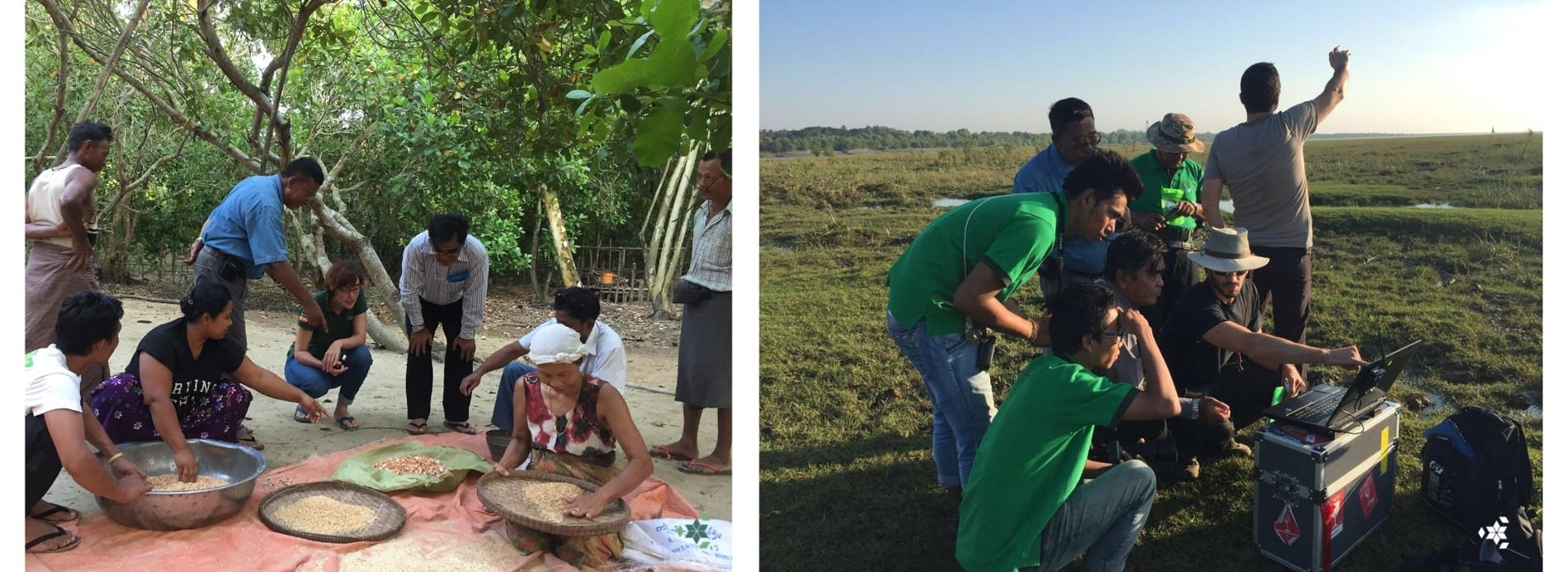
Pictures from one of our projects in Myanmar, working very closely with the local communities on mangrove rehabilitation program.
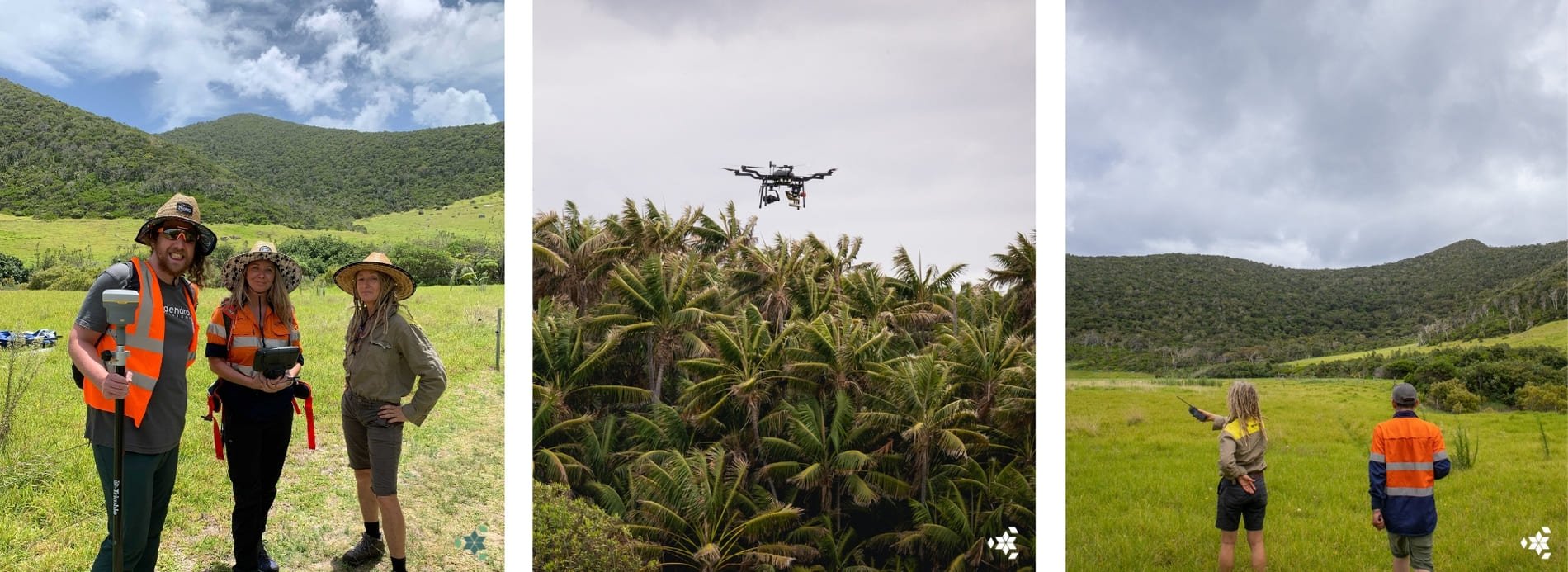
Pictures from Dendra System’s project in LHI, working closely with the Flora and Weed Management Officer at Lord Howe Island Board.
10- Adapt to Natural Evolution
Plants are sensitive barometers of change within an environment. Their structures and life cycles and their interactions with other organisms relate to the local conditions of where they grow. Plants adapt to varying temperatures and moisture conditions to cope with challenging and extreme conditions. Plants grow and develop through a series of successions, becoming bigger, more complex and interconnected at each stage and, eventually, taking the most complicated interconnected form that the environmental conditions will allow. How they respond and adapt to environmental changes such as soil conditions, hydrology and pollution can provide plenty of information about the ecosystem and help identify and detect any challenges.
In response to a changing climate, it is forecasted that some ecosystems will start to sequester more carbon dioxide, however globally there will be more ecosystems negatively affected, leading to a net emission of carbon dioxide for the world¹⁷.
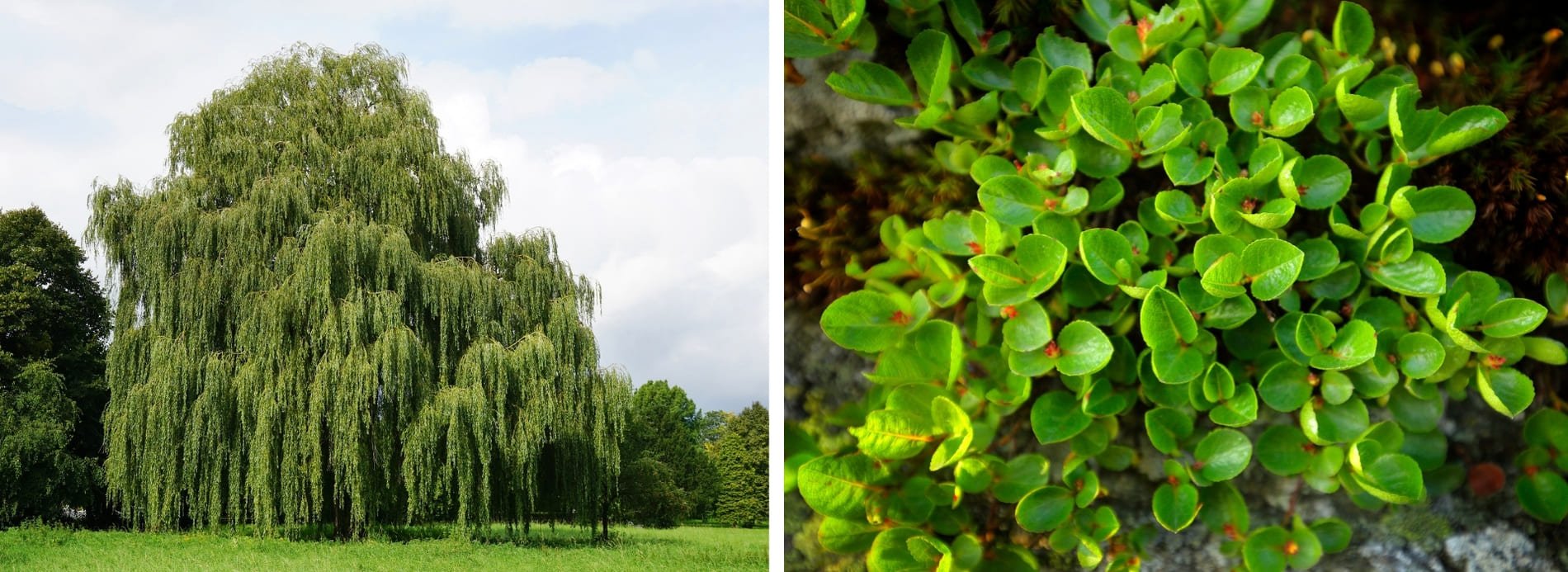
The salix family, which is native to China, has over 500 species that have adapted to different environmental conditions. Compare the weeping willow tree (Salix babylonica), which is usually found in very moist soils, usually near water, to the dwarf willow (Salix herbacea), which distributed widely in alpine and arctic environments around the North Atlantic Ocean, adapting to survive in harsh arctic and subarctic environments.
Ecosystem restoration activities need to undertake an adaptive management approach to the changing variables of our constantly evolving environmental conditions due to climate change.
“The goal of ecological restoration is to return a degraded ecosystem to its historic trajectory, not its historic condition. The ecosystem may not necessarily recover to its former state since contemporary ecological realities, including global climate change, may cause it to develop along an altered trajectory, just as these same realities may have changed the trajectory of nearby undisturbed ecosystems. History plays an important role in restoration, but contemporary conditions must also be taken into consideration”¹⁸.
Ecosystem restoration is more than just planting trees. It’s a complex process that needs to be done appropriately and thoroughly, it needs to take multiple variables into account or it could be counterproductive and harm the ecosystems even further. We need to ensure it involves the right stakeholders and the required expertise to bring some rigour associated with what we plant, with how we monitor restoration progress and how we manage that diversity back.
The outlined ten actions are critical to restore ecosystems effectively and maximise their capabilities to sustain human livelihoods, mitigate climate change and to provide many more benefits to societies and economies globally.
The health of our lives and our economy depend on the health of our planet. Only with healthy ecosystems can we enhance and protect people’s livelihoods, counteract climate change, and stop the collapse of biodiversity, preventing the extinction of even more species.
References
1. IPBES Global assessment report (2019) 2. UN SDG- Life on land, Link: https://www.un.org/sustainabledevelopment/biodiversity/ 3. Making peace with nature, UNEP, (2020) 4. UN SDG- Life on land, Link: https://www.un.org/sustainabledevelopment/biodiversity/ 5. SER, Society for Ecological Restoration, Link: https://www.ser-rrc.org/what-is-ecological-restoration/ 6. Ecosystem Systems, UK National Ecosystem Assessment, (2021), Link: http://uknea.unep-wcmc.org/EcosystemAssessmentConcepts/EcosystemServices/tabid/103/Default.aspx 7. Ecosystem services and biodiversity, European Commission, (2015), Link: https://ec.europa.eu/environment/integration/research/newsalert/pdf/ecosystem_services_biodiversity_IR11_en.pdf 8. IPBES Global assessment report, (2019) 9. UN Report: Nature’s Dangerous Decline ‘Unprecedented’; Species Extinction Rates ‘Accelerating, (2019), Link: https://www.un.org/sustainabledevelopment/blog/2019/05/nature-decline-unprecedented-report 10. Ten golden rules for reforestation to optimize carbon sequestration, biodiversity recovery and livelihood benefits, Alice Di Sacco and Kate A. Hardwick, (2021), Link: https://onlinelibrary.wiley.com/doi/full/10.1111/gcb.1549811. 11. Ten golden rules for reforestation to optimize carbon sequestration, biodiversity recovery and livelihood benefits, Alice Di Sacco and Kate A. Hardwick, (2021), Link: https://onlinelibrary.wiley.com/doi/full/10.1111/gcb.15498 12. Indicator: Forest Carbon emissions and removals, (2018), Link: https://www.nrcan.gc.ca/our-natural-resources/forests-forestry/state-canadas-forests-report/how-does-disturbance-shape-canad/indicator-carbon-emissions-removals/16552 13. Restoration of ecosystem interactions in yellowstone national park, USA, with reintroduction of grey wolves, University of British Columbia, Link: https://cases.open.ubc.ca/w17t2cons200-18/ 14. Advances in seed conservation of wild plant species: a review of recent research, Hay and Probert, (2013), Link: https://academic.oup.com/conphys/article/1/1/cot030/365220 15. UC Weed Research & Information Center (2010), Link: https://wric.ucdavis.edu/PDFs/pampasgrass%20and%20jubatagrass%20WRIC%20leaflet%2099-1.pdf 16. Galapagos Conservancy, Link: https://www.galapagos.org/conservation/our-work/ecosystem-restoration/project-floreana/ 17. The global tree restoration potential, Jean-Francois Bastin, Yelena Finegold, Claude Garcia, Danilo Mollicone, Marcelo Rezende, Devin Routh, Constantin M. Zohner, Thomas W. Crowther, (2019), Link: https://science.sciencemag.org/content/365/6448/76.abstract 18. SER, Society for Ecological Restoration, Link: https://www.ser-rrc.org/what-is-ecological-restoration/
